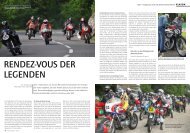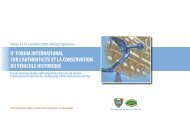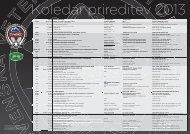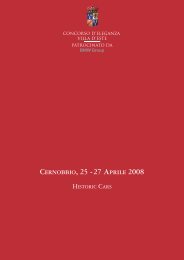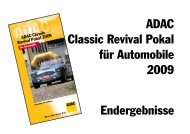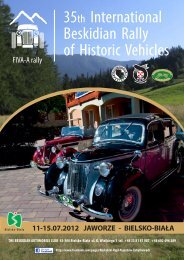FORUM INTERNATIONAL SUR L'AUTHENTICITE DU VEHICULE HISTORIQUE ...
FORUM INTERNATIONAL SUR L'AUTHENTICITE DU VEHICULE HISTORIQUE ...
FORUM INTERNATIONAL SUR L'AUTHENTICITE DU VEHICULE HISTORIQUE ...
You also want an ePaper? Increase the reach of your titles
YUMPU automatically turns print PDFs into web optimized ePapers that Google loves.
.6<br />
154<br />
dilemme général entre possibilité de breveter et<br />
impossibilité de breveter du body-panel il faut<br />
distinguer entre res compositore ex cohaerentibus,<br />
c’est-à-dire des parties destinées à être totalement<br />
intégrées dans la forme globale externe de la voiture<br />
(comme pare-chocs, portes, capot, et similaires,<br />
toutes partie non brevetables à priori) et res<br />
compositae ex distantibus, c’est-à-dire parties<br />
internes ou externes n’ayant pas la fonction<br />
d’intégration totale dans le tout, pour lesquels la<br />
possibilité de breveter serait admissible<br />
(généralement) en présence des conditions requises<br />
par la loi. L’autorité de la décision est le nom de son<br />
rédacteur (président du collège) célèbre auteur<br />
d’œuvres fondamentales de droit industriel.<br />
C) Une ultérieure sentence de la Cour d’Appel de<br />
Turin du 7 novembre 1995 (Dir. ind. 1996, 357) qui<br />
adopte la nouvelle “thèse Vercellone”.<br />
7) La première intervention de la Cassation<br />
(sentence n. 6644 de 1996)<br />
En 1996 la Cour Suprême (Cass 24 juillet 1996, n.<br />
6644) clôture définitivement le cas “Golf<br />
Volkswagen” - connu en doctrine comme “cas<br />
Hella/Aric”, déjà analysé par le Trib. Turin 21 avril<br />
1990 (cit.) et App. Turin 18 janvier 1993 – en niant à<br />
priori et par principe la possibilité de breveter des<br />
pièces de rechange de carrosserie (on rappelle qu’il<br />
s’agissait des phares arrière de la “Golf”, c’est-àdire<br />
les pièces séparées de la carrosserie<br />
d’automobiles ou body panel).<br />
“Pour la validité d’un brevet pour modèle<br />
ornemental, ex. art. 2593 c.c. et art. 5 l. mod - affirme<br />
la S.C. - dont la finalité est celle de défendre et de<br />
récompenser une idée créatrice à travers la<br />
reconnaissance du droit à l’exploitation exclusive de<br />
la même idée, il faut que subsiste, en rapport à<br />
in presenza dei requisiti di legge. L’autorevolezza<br />
della decisione è nel nome del suo estensore<br />
(presidente del collegio), noto autore di opere<br />
fondamentali di diritto industriale.<br />
C) Un’ulteriore sentenza della Corte d’Appello di<br />
Torino del 7 novembre 1995 (Dir. ind. 1996, 357) che<br />
adotta la nuova “tesi Vercellone”.<br />
7) Il primo intervento della Cassazione (sentenza n.<br />
6644 del 1996)<br />
Nel 1996 la Suprema Corte (Cass. 24 luglio 1996, n.<br />
6644) chiude definitivamente il caso “Golf -<br />
Volkswagen”- noto in dottrina come “caso<br />
Hella/Aric”, già analizzato da Trib. Torino 21 aprile<br />
1990 (cit.) e App. Torino 18 gennaio 1993 – negando a<br />
priori e in via di principio la brevettabilità dei pezzi di<br />
ricambio di carrozzeria (si ricorda che si trattava dei<br />
fari posteriori della “Golf”), cioè alle parti separate<br />
della carrozzeria di autovetture o body panel.<br />
“Per la validità di un brevetto per modello<br />
ornamentale, ex. art. 2593 c.c. e art. 5 l. mod.” –<br />
afferma la S.C. – la cui finalità è quella di difendere e<br />
premiare un’idea creativa attraverso il<br />
riconoscimento del diritto allo sfruttamento<br />
esclusivo dell’idea stessa, è necessaria la<br />
sussistenza, in capo all’oggetto, di un valore estetico,<br />
ovvero di un pregio estetico, che lo caratterizzi sotto<br />
tale profilo in modo autonomo, talchè esso acquisisca<br />
un suo specifico valore di mercato”. Prosegue la S.C.:<br />
“Ne consegue che deve negarsi la brevettabilità di un<br />
prodotto che costituisce parte integrale di un<br />
prodotto più complesso oggetto di autonomo brevetto<br />
quando la forma del primo è necessitata dal fatto di<br />
essere parte del secondo, atteso che non è<br />
consentita l’artificiosa frammentazione di una stessa<br />
idea stilistica sulla base della mera frammentabilità<br />
del corpus mechanicum nel quale essa si è<br />
SAUVEGARDE JURIDIQUE DE L’AUTENTICITE<br />
SALVAGUARDIA GIURIDICA DELL’AUTENTICITÀ<br />
LEGAL SAFEGUARDS OF AUTHENTICITY<br />
Mario Barbuto, IT - Président du Tribunal de Turin<br />
interior or exterior parts not having the role of being<br />
completely integrated in the whole, in which case<br />
patenting would be admissible (generally speaking)<br />
where the legal requisites persist. The<br />
authoritativeness of the decision is in the name of its<br />
drafter (the Presiding Judge of the Bench), famous<br />
author of fundamental works in industrial law.<br />
C) A further sentence by the Court of Appeal of Turin<br />
on 7 November 1995 (Dir. Ind., 1996,357) which<br />
adopts the new “Vercellone theory”.<br />
7) The first intervention by the Court of Cassation<br />
(sentence no. 6644 of 1996)<br />
In 1996 the Supreme Court (Cass 24 July 1996, no.<br />
6644) definitively closed the case “Golf-Volkswagen”<br />
- known in jurisprudence as “the Hella/Aric case”,<br />
already analysed by the Court of Turin 21 April 1990<br />
(cit.) and the Turin Appeal court 18 January 1993 -<br />
rejecting a priori and on principle the possibility of<br />
patenting spare part pieces of the bodywork (this<br />
case regarded the back lights of the “Golf”), that is<br />
the separate pieces of the bodywork of a vehicle or<br />
body panels.<br />
“For the validity of a patent for an ornamental model,<br />
ex art. 2593 of the civil code and art. 5 of the model<br />
law - affirms the Supreme Court - the object of which<br />
is to defend and reward a creative idea through the<br />
recognition of the right to exclusive use of the same<br />
idea, the object must have an aesthetic value, that is<br />
an aesthetic worth, which characterises it<br />
independently in this sense, so that it acquires its<br />
own specific market value - the Supreme Court<br />
continues -It follows that the patenting of an object<br />
must be refused when it constitutes an integral part<br />
of a more complex product with its own patent when<br />
the form of the former is necessitated by the fact that<br />
it is part of the latter, given that the artificial



